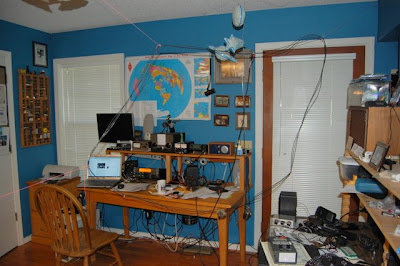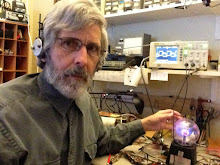I thought the problem might be my use of single conductor wire as opposed to Newkirk's zip cord. I taped and tied my conductors to increase coupling but without much effect. So I decided to rebuild the antenna with zip cord, in my case 2c/#18 speaker wire with clear plastic insulation. I loosely wove the two lengths of cord together as the author had reported that his were "entwined" (sounds romantic - he's a flowery writer).
My initial trails with the new version were disappointing. I tried a number of different fixed capacitors, including 20 pF dipped silver micas, 33 pF postage stamp micas, and 25 pF "doorknob" HV capacitors. In each case I could tune to a resonance but could not get to a low SWR. I even installed a compression mica trimmer in place of the split stator variable with no improvement. Sometimes I could get a low SWR at some point, but tuning to resonance on my desired 40 meter frequency gave a much higher SWR value.
One tangent I got off on concerned the existence of the fourth wire. Mr. Newkirk said he used two loops of zip cord but on 40 meters he just used three wires (turns), sparing the fourth for a future conversion to 80 meters. The article didn't describe whether the spared conductor was broken only at the top or in two places (top and at the matching capacitors at the bottom). Would it make any difference? I had originally cut the condutor in both places, so I jumpered it together at the bottom and found that it made a big difference in the resonance point. The resonant frequency dropped about 1 MHz and the SWR at resonance was well under 2:1. So the spare isn't just hanging around minding its own business.
Too many variables - the quality of the capacitors, the disposition of the spare wire, -- what about balance, which Mr. Newkirk emphasized? Currently I'm having to tune my variable to minimum capacitance to reach 40 meter resonance. That might mean my fixed capacitors (lowest tried - 20 pF) are too large. So I put in two 14.7 pF silver micas. Much better! Now my variable is partially meshed for resonance at 7040 kHz and my SWR is well under 2:1. It seems stable too, and not sensitive to body capacitance.
So that's where I am at this point. No more QSOs yet -- not much activity on 40 and no contests to exploit. I think I'd like to put the antenna on the second floor or even outside to give it a better chance.
It's interesting to note the big difference in capacitor values I wound up with as opposed to those in the article: 14.7 pF for me versus 40 pF for Rod Newkirk.
So now I'm happy with it again. I think it might make a good hotel room antenna. And it's now much easier to fold up due to the superior flexibility of the zip cord.


